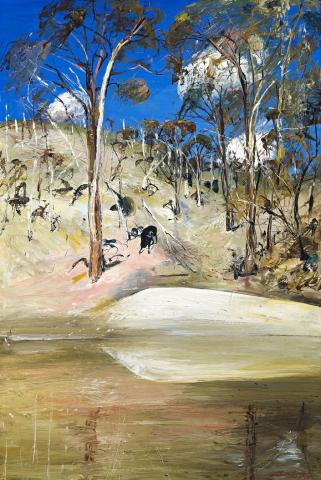WATERHOLE AND RAM, c.1981
ARTHUR BOYD
oil on canvas on composition board
86.5 x 58.5 cm
signed lower right: Arthur Boyd
Corporate collection, Melbourne
Sotheby's, Melbourne, 28 November 2000, lot 56
Kevin Weldon AM, Sydney
Private collection, New South Wales
Waterhole and Ram exhibits Boyd's love of the Shoalhaven region and his beautiful retreat, Bundanon near Nowra on the New South Wales south coast. The property, located several miles from the mouth of the Shoalhaven River, has been a source of inspiration for Boyd since he first visited the area in the late 1960s.
In this painting, we see a classic Boyd Shoalhaven landscape - in portrait format - with the black ram making its way to drink from the waterhole. We know that Boyd enjoyed lacing his work with cryptic symbols; caves, beasts, roses and birds all feature regularly, and serve as metaphors which are often biographical and deal with his own creative dilemmas. The ram in Boyd's paintings has often been considered an image representing carnal lust, but in this work it could equally represent the European occupation of the land with the introduction of hoofed animals doing much to cause land erosion and degradation.
The landscape is dry and scrappy, the sun at high-noon and a bushfire appears imminent. Of particular interest to Boyd was the point where the water meets the land, which provided him with rich options when it came to playing with the light and mood of the river. The large rock that dominates the foreground resembles a large sarcophagus, here reflected in the river and representing the balance of death and renewal which Boyd saw as omnipresent in the Australian landscape.
In Boyd's landscapes, as with many Australian artists, the influence of Tom Roberts can be felt, as can Arthur Streeton's shorthand brush work. As Sandra McGrath writes,
'While Boyd in general chooses to portray the Shoalhaven landscape more indentified with Von Guerard and Buvelot, at other times he cannot resist the temptation to paint the landscape in the manner of the early Box Hill painters ... Despite their reliance on a realistic approach to the subject, the Boyd Shoalhaven landscapes are more varied in technique and style than one might suppose. With his prodigious ability the artist is able to take the nature of the subject and render it in a manner which captures the essence of its particular properties at that time, or imbue it with a sense of character and meaning which is the result of his own immediate emotional or psychological response.'1
On a practical level, Boyd's brushes were a combination of the house painter's and signwriter's mixed with high quality fine art brushes. He had a way of handling the long bristled signwriter's brush that was particularly effective when painting the Australian bush; he would load the brush with paint and flip it around on the surface, which would leave marks that were highly descriptive and spontaneous. As the brush made contact with the surface it would often remove as much paint as it would apply, and this would create a sort of zone that would allow the colour to mix and arrange itself - culminating in rich and unlikely colour arrangements on the surface and the repertoire of unique and varied marks. His most nuanced painting implement was his bare hands, which he often used when he felt the need to convey compassion when painting creatures like fish, dogs, sheep or the human figure.
Waterhole and Ram is in all likelihood a studio painting. Boyd's profound understanding of the Australian landscape meant he could recall the forms and colours at will. In this delightful example Boyd flaunts his ability to introduce rich narrative via symbols such as the ram, and in so doing breaks with realism to create a work that is about the Australian landscape rather than simply a picture of it.
1. McGrath, S., The Artist and The River: Arthur Boyd and the Shoalhaven, Bay Books, Sydney, 1982, p. 63
HENRY MULHOLLAND
